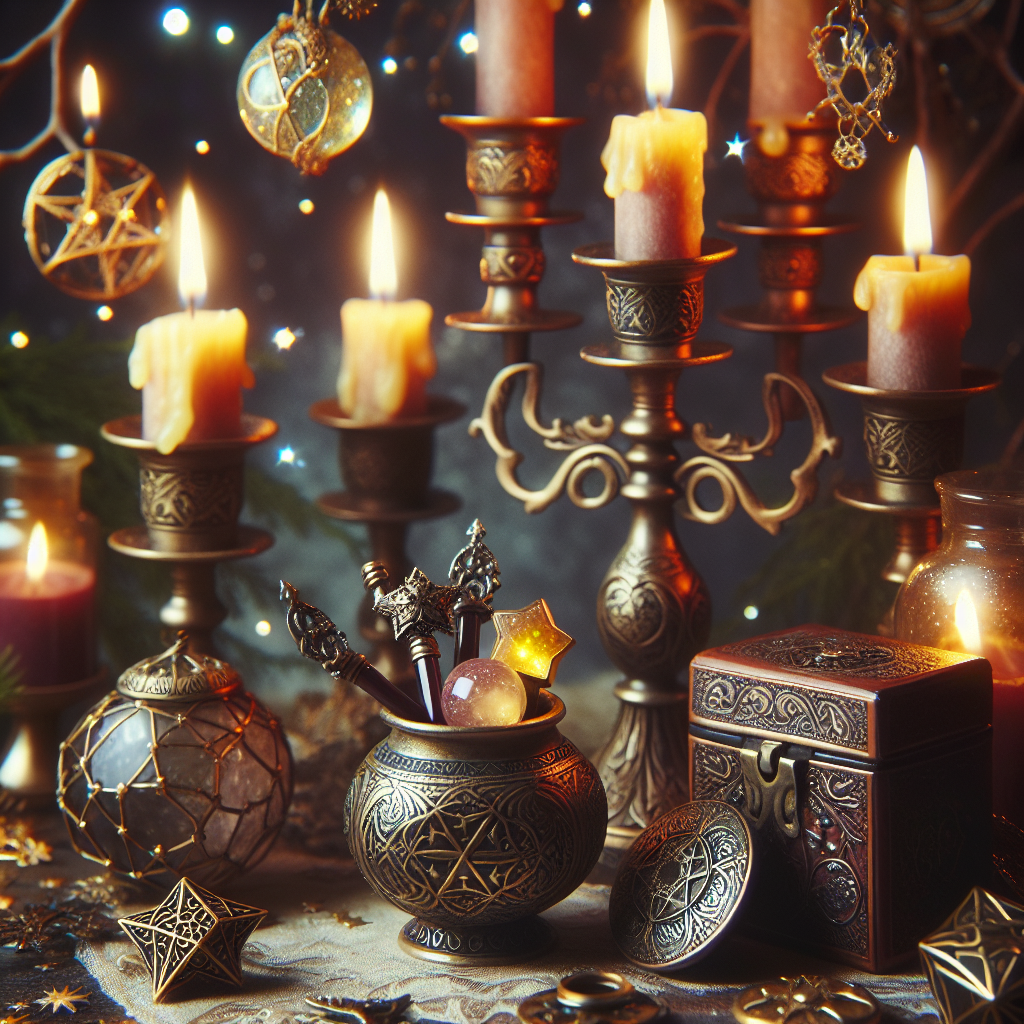As an Amazon Associate I earn from qualifying purchases.

Enchantment, in historical and cultural contexts, often refers to the act of imbuing objects with magical properties or spells. From ancient runes to modern-day witchcraft, the practice of enchanting objects has been a part of human traditions across civilizations. It serves various purposes such as bringing luck, protection, healing, or even harm to others, depending on the enchanter's intentions. With a rise in interest in New Age and pagan beliefs, enchanting objects has re-emerged as a significant facet of contemporary magical practices.
The process typically starts with the selection of an object to enchant. Practitioners of magic will choose an item that has personal significance or is relevant to the spell's intention. Objects made of natural materials such as wood, stone, or metal are often preferred as they are believed to hold the energy of the spell more effectively. The object is then cleansed of any prior energy, which can involve various rituals including but not limited to immersion in saltwater, smudging with herbs, or leaving it exposed under moonlight.
The act of enchanting requires a clear and focused intention; one has to know exactly what purpose the enchanted object is supposed to serve. This is often accompanied by a spoken or written spell, which articulates the intended effect of the enchantment. The words may be repeated several times, and this repetition is thought to charge the object with power. The specific phrases used can be traditional, derived from historical texts, or a creation of the practitioner, reflecting personal creativity in the magical process.
Timing is also considered of great essence in the art of enchantment. Certain phases of the moon or specific astrological alignments are believed to amplify the power of magical workings. For instance, enchanting an object for growth or increase is ideally performed during the waxing phase of the moon, while banishing or reducing might correspond with the waning moon. The belief that cosmic forces can influence the potency of enchantments adds an astronomical dimension to the process.
Intriguingly, some practitioners use tools to aid in the enchantment process. This might include a wand to direct energy, an altar on which to place the object, or candles to represent fire and the transformation it signifies. The choice of colors for these candles, as well as other tools, can be symbolic, corresponding to the intent of the spell, such as green for prosperity or red for passion.
Engaging the senses is another vital aspect of enchantment. Incense or essential oils might be involved to align with the spell's intent, creating a multi-sensory experience. The aromatic aspect is thought to please spiritual entities or to help the practitioner achieve a heightened state of consciousness, which facilitates a stronger magical working.
Despite the mystique surrounding enchanting objects, reported success rates and experiences are highly subjective, with many practitioners claiming significant changes post-enchantment, while skeptics attribute results to psychological effects or coincidence. The practice thus remains deeply personal and is often shrouded in the practitioner's own belief system. Whether the objects derive their power from an external force or from the focused intent and belief of the individual, the practice of enchanting continues to enchant those who participate in its age-old ritual.
“`html
How Can You Cast Spells to Enchant Objects with Magic?
“`
Enchanting objects magickally involves imbuing them with specific energies or intentions through the use of spells and rituals. This ancient practice, rooted in various cultural traditions, allows practitioners to infuse items with magical properties for protection, attraction, healing, and more. By performing enchantments, one can create talismans, amulets, or simply turn everyday items into vessels of magical influence. The advantages of this process include the personalized creation of magical tools that resonate with the user's intent, leading to heightened efficacy in spellwork and the manifestation of desired outcomes. Understanding the proper techniques and principles behind enchanting is essential, which we will explore in further detail in the subsequent sections.
Enchanting Objects Magickally
Selecting the Right Object for Enchantment
Enchanting objects magickally begins with choosing an appropriate item to imbue with your desired intention. The object should be relevant to the purpose of the enchantment and capable of holding the magical energy. For instance, a piece of jewelry might be enchanted to attract love, while a stone could be chosen for grounding and protection. Natural materials like wood, metal, stones, or crystals are typically more receptive to holding magical properties due to their inherent connection to the Earth and elemental energies.
Cleansing the Object
Before beginning the enchantment, it is crucial to cleanse the chosen object of any pre-existing energies. You can cleanse an object by smudging it with sage, palo santo, or incense; using sound vibrations from a bell or a singing bowl; or placing it under moonlight, particularly during a Full or New Moon. This purifying step is essential to create a clean energetic slate for the new intentions.
Setting the Intention
Once the object is cleansed, the next step involves setting a clear and focused intention. The intention should be specific and stated in the present tense as if the desired outcome is already a reality. For example, instead of saying, “I want to attract happiness,” phrase it as “I am filled with happiness.” Hold the object and focus deeply on channeling this intention into it, visualizing the goal being achieved and feeling the emotions associated with its realization.
Selecting the Right Time
Timing can play a significant role in the potency of an enchantment. Many practitioners will plan their enchantment rituals according to the lunar cycle, astrological configurations, or specific days of the week that correspond with the intention. For instance, enchanting an object for abundance might be most effective during the Waxing Crescent Moon, which symbolizes growth and manifestation.
The Enchantment Ritual
The actual enchantment ritual may involve various elements such as incantations, visualization, and the use of corresponding herbs, oils, or symbols to reinforce the intention. While holding the object in your hands, you can recite an incantation that spells out your desire, or you might anoint the object with an oil that complements your intention. Drawing or inscribing symbols on the object that align with your goal can also help seal the enchantment.
Charging the Object
To further empower the object, it should be charged with energy. This can be achieved through meditation, by placing it in direct sunlight or moonlight, or by burying it in the Earth for a period. Some practitioners use their own energy by channeling it through their hands, while others may call upon deities, elementals, or the universal life force to charge the object.
Maintaining the Enchantment
For the enchantment to remain active, periodic maintenance may be necessary. This could mean re-cleansing the object, reiterating the intention, or re-charging the energy. It is important to handle the enchanted item with respect and keep it in a safe place where it won't be disrupted by negative energies.
Understanding Ethical Considerations
When enchanting an object, it's vital to consider the ethical implications of your work. Always enchant with positive intentions and avoid infringing upon the free will of others. The Law of Threefold Return, a core belief in many magical traditions, warns that whatever energy you put out into the world will return to you threefold, underscoring the importance of responsible enchantment.
Respecting the Boundaries of Magick
While objects can be enchanted to aid in various aspects of life, it is essential to understand that magick is not a guaranteed solution to all problems and should be used as a complementary practice to practical efforts and professional advice where appropriate.
A Statistical Insight
A 2014 survey by the Pew Research Center found that approximately 0.4% of the American population identified as Wiccan or Pagan, groups for whom enchanting objects is a common practice. Given the continued rise in interest toward alternative spiritualities, it is likely the practice of enchanting objects magickally has become even more widespread in recent years.
1. What does it mean to enchant an object magickally?
Enchanting an object magickally refers to the process of imbuing an item with specific magical properties or energies. This is typically done with a ritual or spell, intending to let the object serve a particular purpose, such as protection, love attraction, or wealth enhancement.
2. Can any object be enchanted, or are there specific types that work best?
While theoretically, any object can be enchanted, items that are significant or resonate with the practitioner or the intended purpose tend to be more effective. Objects like jewelry, crystals, talismans, amulets, or tools that are consistently in your presence are common choices for enchantment.
3. Do I need any special skills or abilities to enchant an object?
While no special innate abilities are required, it helps to have a clear intention, focus, and understanding of the enchantment process. Often, a consistent practice and study of magical principles and techniques can enhance your ability to enchant objects effectively.
4. Is enchanting an object safe? Are there any risks?
Enchanting an object is generally safe when done with positive intent and proper magical hygiene practices such as grounding, centering, and cleansing. However, like any magical practice, it's essential to consider the energies you're working with and ensure they align with your intentions to avoid unintended consequences.
5. How long does it take for an enchantment to work?
The time it takes for an enchantment to work can vary widely depending on the strength of the spell, the clarity of intention, and the receptivity of the object. Some may notice effects immediately, while others can take days, weeks, or even longer to manifest noticeable results.
6. How can I tell if an object has been successfully enchanted?
You might sense a change in the object's energy, or you could experience coincidences or events related to the enchantment's intended purpose. Occasionally, physical changes in the object can indicate successful enchantment, such as a shift in color or an unexplained warmth.
7. How long will the enchantment last on the object?
The duration of an enchantment can be permanent or temporary, depending on how it was cast. Some enchantments may require regular recharging or reinforcement, especially if they serve an ongoing purpose or are in constant use.
8. Can I enchant an object for someone else?
Yes, you can enchant an object for someone else with their permission. It's essential to clearly understand their needs and intentions and to incorporate those into the enchanting process to ensure the object aligns with their energy and purpose.
9. What if I make a mistake while enchanting an object?
Mistakes in enchanting can usually be rectified through cleansing and reconsecrating the object. Taking time to closely review the enchantment process and refocusing your intentions can also help correct any errors.
10. How do I maintain the magical charge of an enchanted object?
To maintain an object's magical charge, regularly cleanse it of any negative energy and reaffirm your intentions for it. Depending on the type of enchantment, you might also need to perform periodic rituals or recharge the object during certain moon phases or after it has been used for a specific purpose.

Conclusion
To enchant an object magickally, we must first acknowledge the significance of intent and focus. The power of enchantment is rooted in the clarity and strength of the practitioner's will. Key elements such as choosing an appropriate object that resonates with the intent of the enchantment, preparing the space and the object through cleansing rituals, and imbuing the item with specific energies or intentions during a dedicated ritual have been emphasized. It is imperative to align the enchanting process with the lunar cycle, astrological correspondences, and personal energy for the enchantment to harness its full potential.
Lastly, the maintenance of the enchanted object should not be overlooked. Regularly recharging the object, either through meditation, exposure to elements, or during ritual work ensures the longevity of the enchantment. The need for discretion and protection of the enchanted object from outside influences has also been established as critical to preserving its magical integrity. Ultimately, the success of enchanting an object magickally rests upon the harmony between the practitioner's intent, the energies utilized, and the respect given to the magical practice itself.
Amazon and the Amazon logo are trademarks of Amazon.com, Inc, or its affiliates.


